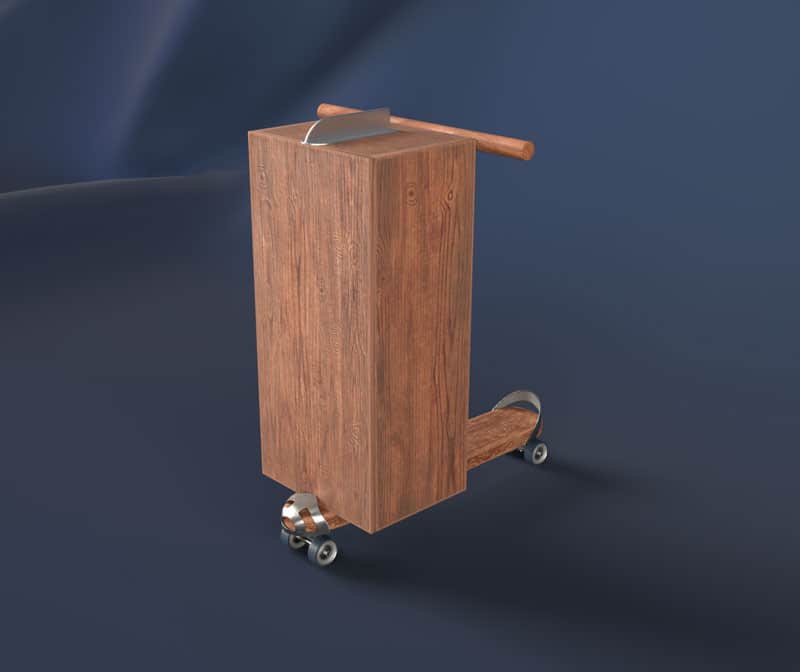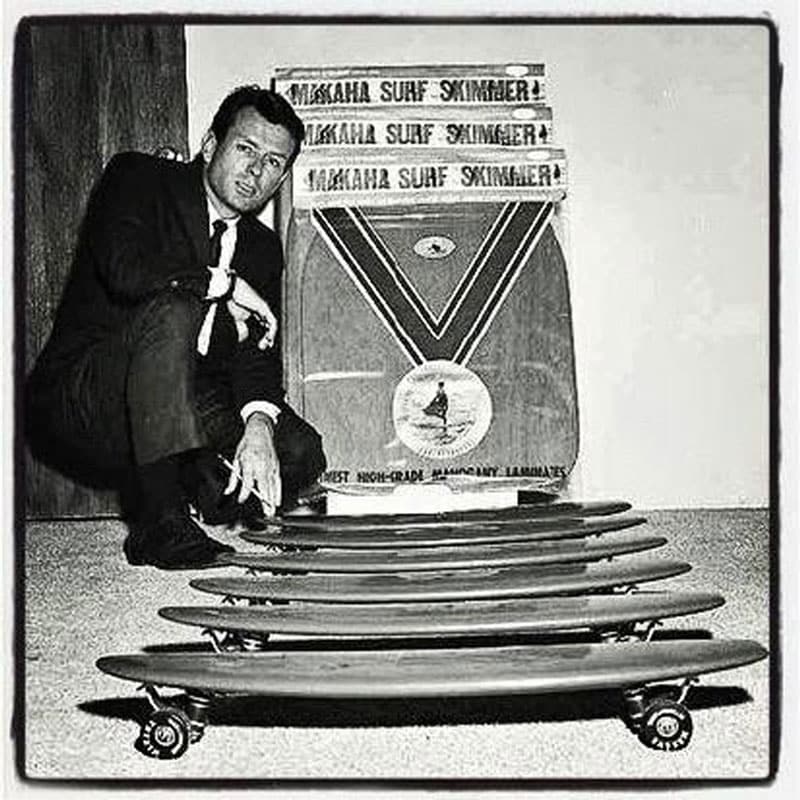Kids have always had an affinity for their own set of wheels. The bicycle is the prime example, but for a long time bikes were out of reach financially for many families. The alternatives were wagons, scooters and roller skates.
When these store-bought vehicles didn’t do the trick, young people resorted to creating their own conveyances. Some built go-karts or soapbox carts; others made what would end up being the early form of the skateboard.
Early 1900s
This first type of skateboard, which dates back to the early 1900s, was actually more like a scooter. It featured roller skate wheels attached to a two-by-four. Often the board had a milk crate nailed to it with handles sticking out for control. Over the next five decades kids changed the look of these contraptions, taking off the crate and cruising on just the two-by-fours with steel wheels. Tens of thousands of rollerskates were dismantled and joyfully hammered onto planks of wood.

After the Second World War, North America experienced a booming economy and an expanding population. The baby boomers quickly made their presence felt in the marketplace. The 1950s would see toy manufacturers stumbling over themselves to come up with the next fad to capture the imaginations and piggy banks of kids everywhere. The appearance of television would help them along. Yo-yos, hula hoops and the like would rise and fall in favor on the playground. It was only a matter of time before someone picked up on the potential lying in those roller skate wheels nailed to hunks of wood. The first commercial skateboards hit the marketplace in 1959.

1959 – 1965
The dawn of the commercial skateboard industry brought new and exciting technological advances, like clay wheels, that made the ride smoother and new tricks possible. But it also signaled an end to a time when kids gleefully and messily and ingeniously devised their own playthings.
The late 1950s saw growing commercial interest in the skateboard concept, and by 1959 the first Roller Derby Skateboard had appeared on store shelves. The introduction of commercially produced skateboards coincided with the era of the surfer, and people began to tie riding the waves with cruising on a board on land. By the time the 1960’s rolled around, skateboarding had gained a sizable following among the surf crowd.
But it was when Larry Stevenson, publisher of Surf Guide, began to promote skateboarding that things really started to take off. Larry’s company, Makaha, designed the first professional skateboards in 1963, and a team was formed to promote the product.

Traveling skateboard teams sponsored by skateboard makers would become a staple of skateboard marketing and play a big role in bringing skateboarding to the world. Makaha also sponsored the first skateboard contest, held in Hermosa, California, in 1963. Formal skateboard competitions raised the standards of skateboard performance and gave it its sport status.
More skateboard manufacturers appeared on the scene. By 1965, international contests, movies (Skater Dater), a magazine (The Quarterly Skateboarder) and cross-country trips by teams of skateboarders had elevated the sport to enormous heights of popularity.
Over fifty million boards were sold within a three-year period.
Then, all of a sudden, skateboarding died in the fall of 1965.
1965 – Crash
The first skateboarding crash was due to inferior product, too much inventory and a public upset by reckless riding. The manufacturers were so busy making boards that little had been done in the way of research and development. Beyond replacing the squeaky steel roller skate wheels with smoother-riding clay wheels and refining the trucks (the devices that hold the wheels), there were few technological advances.
Some companies did develop better quality wheels, but clay wheels were the cheapest to manufacture. Clay wheels did not grip the road well, however, and skaters everywhere were having some nasty falls. Cities started to ban skateboards in response to health and safety concerns, and after a few fatal accidents, skateboarding was officially drummed out of existence. Manufacturers lost huge amounts of money due to canceled orders for the Christmas season, and skateboarding virtually disappeared from public view.
But a few truly dedicated skaters would keep the sport alive on life support.
1973 – 1980
The late sixties seem to have been a less innocent time than the early years of that decade. Legal problems and a lack of innovation in skateboard design were the main factors in the downturn in the popularity of skateboarding that occurred in that period, but it was also a time of great political and social strife worldwide, and carefree activities like sidewalk surfing were eclipsed in the public’s imagination by protests, assassinations, and an increasingly controversial war.
Skateboarding didn’t disappear entirely, but it certainly entered a dormant phase, until a technological breakthrough would bring it back to the forefront. In 1970, a surfer by the name of Frank Nasworthy began developing a skateboard wheel made from urethane. The resulting ride was magnificent compared to clay wheels, and by 1973 Nasworthy’s Cadillac Wheels had launched skateboarding’s Second Wave.
Truck manufacturers like Independent, Bennett and Tracker began making trucks specifically designed for skateboarding. Board manufacturers sprang up overnight, and suddenly the industry was awash with new products and new ideas. In 1975, Road Rider came out with the first precision-bearing wheel, ending, years of loose ball bearings that had a habit of spilling out.
Slalom, downhill and freestyle skateboarding were practiced by millions of enthusiasts. SkateBoarder magazine was resurrected, and was soon joined by other publications hoping to cash in on skateboarding’s comeback. Bruce Logan, Russ Howell, Stacy Peralta, Tom Sims and Gregg Weaver were featured heavily in these magazines. The sport was on a roll once again.
The first modern outdoor skateboard park was built in Florida in 1976 and was soon followed by hundreds of other parks all over North America. With all the new possibilities the skateparks offered, skateboarding moved from horizontal to vertical and slalom and freestyle skateboarding gradually became less popular. The width of skateboards also changed from six to seven inches to over nine inches. This increase in size ensured better stability on vertical surfaces. Top riders of the Second Wave included Tony Alva, Jay Adams and Tom “Wally” Inouye. Wes Humpston marketed the first successful line of boards with graphics under the Dogtown label. Soon, dozens of board manufacturers were putting graphics under their boards.
Pool skating was hugely popular and as a result of better technology, skaters were able to perform aerials and go well beyond the coping. In the late 70’s, Alan Gelfand invented the “ollie” or no-hands aerial, and moved skateboarding to the next level. The roots of streetstyle developed when skaters started to take vertical moves to flatland. Skateboard culture began to mesh with punk and new wave music. Images of skulls began to appear on skateboards, thanks to the creative genius of Vernon Courtland Johnson at Powell Corporation.
But skating’s old nemesis, safety concerns, arose once more. Insurance became so expensive that many park owners closed their doors and the bulldozers were brought in. By the end of 1980, skateboarding had died another death and once again, many manufacturers were faced with tremendous losses. As BMX biking became popular and SkateBoarder magazine turned into Action Now, a lot of skaters deserted the sport. Skateboarding moved underground once more. But even as the skateparks disappeared, a hardcore contingent built their own backyard halfpipes and ramps and continued to develop the sport.
1983 – 1991
More legal wrangling and competition from other youttIrWiligli BMX biking led to a second fallow period for skateboarding in the early 1980s. Although skate contests were held, the turnout was small and the prize money was even smaller. But, as in the past, a core of dedicated skaters kept the sport alive.
In 1981, Thrasher magazine began publication in an effort to provide hardcore skaters with information on the skateboard scene. By 1983, skate manufacturers were beginning to see the sport on the upswing and Transworld Skateboarding magazine entered the skate scene. Vert riding took off in 1984, followed closely by streetstyle skating. Launch ramps became popular. Powell Peralta created the first “Bones Brigade” skate video, which helped to propel skateboarding to new levels of popularity.
Numerous vertical champions emerged. including Tony Hawk, Christian Hosoi, Lance Mountain and Neil Blender. In the street, Mark Gonzales, Natas Kaupas and Tommy Guerrero created new ollie variations. Freestyle skateboarding was also a part of the scene and Rodney Mullen dominated all competition.
Board royalties and contest winnings escalated, and some pro skaters pulled down earnings of ten thousand dollars a month. The National Skateboard Association, headed by Frank Hawk, held numerous contests across North America and eventually throughout the world. Dozens of new manufacturers sprung up, but in the mid to late 1980’s three handled most of the skate market — Powell Peralta, Vision/Sims and Santa Cruz. Skateboard shoes from Airwalk, Vans and Vision became enormously popular, along with skate fashion, even among non-skaters.
Toward the end of the decade, the focus shifted to streetskating, and vert riding became less popular. A number of pro skaters decided to leave the larger manufacturers and start their own skate companies. One of the first to do this was Steve Rocco, who started up World Industries. “New school” skateboarding was born. Its focus was on ollies and technical tricks, and it took on a whole new attitude.
By 1991, a worldwide recession hit and the skate industry was deeply affected. As in the past, a number of manufacturers were faced with large financial losses. The industry turned extremely negative and began the process of reinventing itself.
1993 – Current
Economic recession put a damper on all industries in the early 1990’s. Skateboarding also had to contend with a new nemesis — Rollerblading. As in the past, a hardcore contingent remained with the sport, but this time the attrition was not as great as it was in the past. The growth of cable television, satellite TV and the Internet would lead to greater worldwide awareness of skateboarding. The “baby boomlet ” — the offspring of the baby boomers — were hitting their rebellious teens.
This, combined with their significant spending power, led to skateboarding’s fourth, and possibly permanent wave. Those kids who took up skating in the ’70s now have kids of their own, to whom they want to pass on the fun and liberation of skateboarding. And many of those young moms and dads are digging out their old boards and hitting the pavement once more themselves. By the mid 1990’s, skateboarding once again reemerged and the fourth wave had begun. In 1995, skateboarding gained a great deal of exposure at the ESPN 2 Extreme Games. Skateboard shoe manufacturers like Etnies and Vans begin selling huge quantities of product and were joined by other soft good manufacturers eager once again to cash in on skateboarding’s popularity.
At the end of the 1990’s, skateboarding’s focus remains streetstyle and the industry is filled with numerous manufacturers and marketers. In many cases, pro skaters develop their own product and manage their own companies. Longboarding, a once forgotten art featuring large boards, has begun to make a comeback, and downhill skateboarding has entered a whole new dimension thanks to street luge.
In California, public skateboard parks are beginning to be built once again, thanks to a change in legislation. The hard work of Jim Fitzpatrick and the International Association of Skateboard Companies has ensured that other states will follow, and more parks are scheduled for construction over the next few years.
Over the past 40 years, skateboarding has had its peaks and valleys of popularity. Poor product, issues of safety, and economic recessions have all contributed to the valleys. However, skateboarding technology has vastly improved since clay wheels. In terms of injuries, the sport remains much safer than football, Rollerblading or hockey (when you look at percentage of participants injured). Despite safety concerns or economic recessions, the sport endures simply because it is so much fun!



